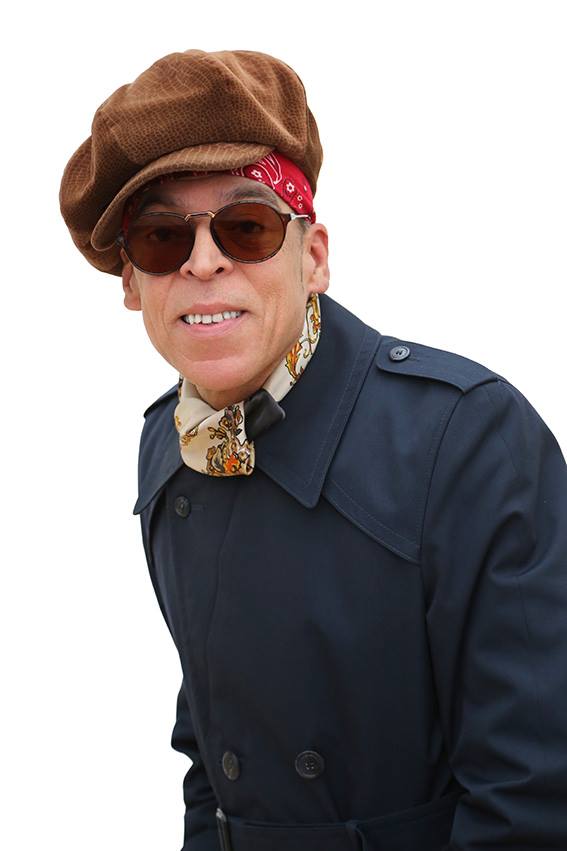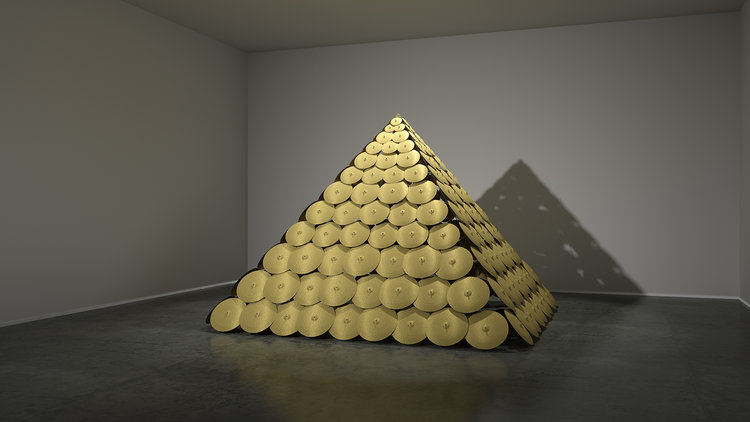Prospect 4 is an international contemporary art triennial, taking place now through February 25 at 17 venues across New Orleans. Its theme is the Lotus In Spite of the Swamp, using as its metaphor a flower that takes root in the mud and then blossoms above the murky water. The idea is to offer artworks that ponder the connection between New Orleans and the world in an era of increasing globalization. Recently we sat down with Prospect.4 artist Satch Hoyt, a London artist, painter, sculptor and musician who lives in Berlin and is an artist in residence at the Joan Mitchell Center in New Orleans.

P.4 artist Satch Hoyt (Photo: Joan Mitchell Center via Facebook)
Give us a little background on your art, specifically the pieces that you’re doing for Prospect.4.
Well, the three commissions for Prospect.4 have definitely been inspired by the sonic history of New Orleans, and also the colonial history of New Orleans. My work is very much focused on what I term the migration of the eternal Afrosonic signifier. Next year I’ll be doing my first Afrosonic mapping, tracing all of history’s bio-sonic mutations.
Explain sonic mutations. Explain this thread of sound you’re following around the globe.
Slaves acted as porters and carried this pneumonic network of sound over to the Carribean basin and over to the Americas. One of the best examples of a sonic amalgamation would be Congo Square. African music, French classical, Irish, first nation music — that hybridization, that amalgamation, made what you now know as jazz.
It’s the eternal migration. And this is what I’m looking at. I’m looking at the way that music is evolving, especially music from the diaspora, the way that it’s going back to the continent, so that there was this constant cyclic sonic relation between the continent and the transnational diaspora.
So you are a musician or an artist?
I’m an artist. But, coming from a working-class background, the idea of being a visual artist was not even considered. Even the idea of being a musician wasn’t really accepted until I was actually on the TV, so I was a professional musician from the age of 16. When I was 17, I started off in a theater, doing musicals and then just music, and then later on made that transition, while I was living in Paris, from musician to visual artist.
Tell us about your works for Prospect.4 in New Orleans.
My works for Prospect 4 are made from musical instruments. Ascension is made with 20 tambourines linked as a chain, with a mirror at the top and a mirror at the bottom, so it’s this infinite feeling that the viewer experiences. The other piece in the U.S. Mint is again made from tambourines and it’s called Redemption. It resembles a Congo cross, because a lot of people from the Congo came over here during that whole middle passage period.
And then the other piece, which taps very much into Afro futurism, is a pyramid, 11 foot by 15 foot. And it’s comprised of 216 cymbals. It acts as a pyramid of fame because each cymbal is dedicated to a pioneering musician from here, from New York, from Jamaica, from Barbados, from Nigeria. It’s just very much focused on, again, the transformation of the transnational diaspora and the diaspora on the African continent and musicians and culture makers who have already made an impact from those places. Inside of the pyramid, there’re rotary fans that activate the cymbals so the cymbals are already overlapping, so there’ll just be this constant sound.

Satch Hoyt’s ‘Splash Ride Crash’ for Prospect.4 forms a pyramid of 216 cymbals, each representing a musician (Photo: Satch Hoyt)
Why did you pick cymbals?
Well, one thing that immediately comes to my mind is aesthetics, and I love bling, so there’s often this element of bling in the work that I do. But, yeah, I just love the sound of cymbals and I’m also a percussionist, so I’ve obviously had this affinity with percussion instruments. Things started off with a drum, the beat, the heartbeat, the drum, the word. In the beginning was the word. I say in the beginning was the beat.
Do you seek tension in your art? What are people supposed to get out of your works?
Well, the works are definitely multilayered and I’m a hybrid. So this idea of mashups and hybridization is extremely important to me — the idea that, you know, the work is very, very layered but it’s also very attractive, because I want to seduce the viewer. I want to bring the viewer into my layer, so to speak, and then the viewer has the choice to decipher or to investigate whatever he or she wants to, but there’s this activist element. I was an activist before I was a visual artist. And there’s the historical aspect, then there’s the sonic aspect and then there’s the fantasy, because without the imagination, where would an artist be? The work is very multilayered and I give that choice to the viewer to investigate whatever she or he wants to do. But it’s all in there, and I can defend those works from all of those levels.
I mean, you go from the literal to the figurative with a lot of layers, a lot of depth in between. There’s also the found object aspect, and the objects in themselves have to already have a serious narrative.
You are European, but how much does African history and the diaspora of African people infuse your work?
It totally infuses my work. It’s funny, because I’m actually doing the Joan Mitchell Center residency and Joan Mitchell was informed by his mother taking him to museums. And my mother never took me to a museum. In fact, there were never any books in my house. But before I knew about Monet or Picasso, I knew about African sculpture. And I was actually making copies of bronzes and, at like 15 and 16, doing crude imitations of masks. That’s how I was initially informed.
You’ve talked about constructing a new cultural identity. What do you mean by that?
I’ll tell you what it is from an artist’s point of view. It’s about rewriting the canon from a nonwhite male perspective. So many people have been left out of the canon, and then we start thinking about how are people being included and who is being facilitated. So I’m very involved in this rewriting of the canon.
Next year I’ll be doing my first Afrosonic mapping, which will entail me taking a 1905 African recording made by Leo Frobenius, one of the first German anthropologists … and then from there going to Rwanda, from there to Zaire and up to Lisbon and, in fact, that is a slave route. But I’m looking at it from what good, what elements of positivity came out of slavery? What came out of the middle passage? And I think, hands down, we all have to say it was sound, it was music. And I think one of the most important cultural gifts that America has given to the world has been jazz, and that we have to all take our hats off to Duke Ellington, Basie, Body Bone, Jelly Roll Morton. You know, New Orleans is very, very important in this conversation.
So what do you think of New Orleans?
I think that you couldn’t meet a friendlier group of people at the end of the day. Obviously there’re some problems here. I mean gentrification is a global problem. But this New Orleans is a very, very magical place. I love the ritual aspect of New Orleans and the second lines and the culture is so strong. I would say it’s the most African of states in the United States that I’ve been to and its vibrancy is really amazing and people are just so friendly and welcoming. I could imagine myself living here easy. With my Jamaican roots, this being the northernmost part of the Caribbean, yeah.
You have exhibited all over the world, from China to Puerto Rico. How much is the work you do formulated by sense of place wherever you are?
Quite often, I’ve exhibited one particular piece called Say it Loud. It’s not the only piece that I’ve exhibited globally, but I like to call that into focus because Say It Loud investigates colonial histories and it’s essentially a conversation with local communities. And that’s very, very important for me, especially when I’m commissioned, that I’m not going to just plunk something down willy-nilly without having conversations with community leaders and knowing something about the history.
I did a project in Cali, Colombia and it’s actually going to be a performance that I’m going to do here for the closure of Prospect.4. It’s called Hair Combing Cycle; in Colombia it was called Hair Combing Cycle 1530 because 1530 was the date of the first slave revolt. If you can, imagine a circle of women all wearing their hair completely natural, no extensions and assigning them different rhythms per pair, and above everyone’s head is a microphone and it’s amplified. It’s a detanglement of colonial histories. We’re going to be doing it here. The first German slave revolt in town and was 18-something and so we’re pulling together 18 women and inviting them to participate in that particular performance for the closure of Prospect.4.
What are you going to take with you from New Orleans back to Berlin?
A big bottle of Crystal pepper sauce.
Satch Hoyt’s Prospect.4 works in New Orleans can be seen at the U.S. Mint, 400 Esplanade Ave. For more on Prospect.4, go to www.prospectneworleans.org.
 NOLAbeings
Multimedia artist Claire Bangser created NOLAbeings as a portrait-based story project that marries...
NOLAbeings
Multimedia artist Claire Bangser created NOLAbeings as a portrait-based story project that marries...
 Data corner: Adobe Suite (create a PDF, social media graphic, presentation, edit a photo and video
Data corner is where you go to work with analytics and top tech skills. It takes on everything from PERL and SQL to Canva and Sprout Social.
Data corner: Adobe Suite (create a PDF, social media graphic, presentation, edit a photo and video
Data corner is where you go to work with analytics and top tech skills. It takes on everything from PERL and SQL to Canva and Sprout Social.
